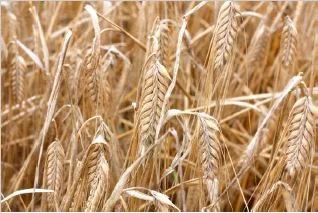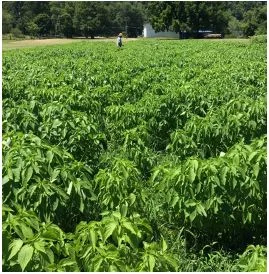The overall objective of the research trials were to develop the best recommendations for managing Fusarium head blight (FHB; also known as scab) and the associated mycotoxin deoxynivalenol (DON; also known as vomitoxin) with foliar fungicides.
Read MoreThe Virginia Tech barley-breeding program is the largest and until recently was the only remaining public program in the eastern United States. The barley program is significantly diverse with breeding efforts focused on the development of superior, widely adapted, high yielding winter barley cultivars and a major focus on the incorporation of value-added traits geared towards the development of new markets.
Read MoreWork conducted at University of Kentucky and also by Chris Kummer has indicated that chia, Salvia hispanica, has the potential to be an economically viable new crop for Kentucky farmers, but agronomic improvements and/or additional product markets are needed.
Read MoreIn 2016, the irrigation system was calibrated and wheat was established that fall to examine the effect of wheat canopy temperature on final grain yield in 2017 growing season.
Read MoreWith these limited results, it appears that it might be possible to increase yields of corn and soybeans by 25% on the fragipan soils by using an annual ryegrass cover crop. We also expect to improve the yields of wheat. A 25% increase would result in $500,000,000 in increased returns to Kentucky producers per year or $5,000,000,000 over a 10-year period on the 1.5 million acres of cropable fragipan soils in Kentucky.
Read MoreKentucky Small Grain Grower leaders Pat Clements and Bernard Peterson were among 30 wheat farmers who attended the National Association of Wheat Growers DC fly-in to discuss the farm bill with Congress.
Read MoreKentucky grain farmers are harvesting corn and are getting to the point where they will decide if and how much wheat they will plant this fall. The main changes this year are a modest increase in wheat prices, a small increase in soybean prices, and a slight decrease in nitrogen prices. These changes will make planting wheat more attractive relative to last year. The following analysis attempts to quantify the extent of the relative change in profitability for 2017. The analysis includes estimated returns comparing double-cropped wheat/soybeans with full-season soybeans for the 2018 crop, and the likely implications for Kentucky grain farmers.
Read MoreU.S. farmers produced lower volumes of a very good SRW crop for marketing year 2017/18. This SRW crop has uniformly low dockage, good test weight, somewhat lower protein, very good kernel size and weight, low DON values and no notable pockets of low falling number. Flour extraction rate is somewhat lower than last year. That is a good summary of results from USW’s 2017 SRW Quality Survey Report, now posted online at www.uswheat.org/cropQuality.
Read MoreJ Stephen Emmick and Sons Farms are the 2017 Kentucky Wheat Yield Contest Winners with a yield of 126.46 Bu/A using No-Till and Pioneer 25R50.
Read MoreThe Kentucky Small Grain Growers Association Board and Promotion Council voted this month to invest $250,000 in new graduate housing for the University of Kentucky Grain and Forage Center for Excellence and an additional $290,000 in UK grain-related research projects. KySGGA’s contribution to the Center since fundraising began in November 2015 totals $785,000. This amount will be added to the Center’s goal of raising $15 million to be matched by the Kentucky Agricultural Development Fund.
Read MoreKentucky farmers expect to harvest 26.2 million bushels of winter wheat during 2017. The expected crop for 2017 would be down 18 percent from the previous year. The forecast was based on crop conditions as of July 1, and increased four percent from the June forecast.
Read MoreThe University of Kentucky Small Grain Variety Testing Program evaluates wheat and barley varieties that are commercially available or may soon be available to farmers. Annual variety performance testing provide farmers, seed producers, extension agents and consultants with current, unbiased information to help them select the varieties best adapted to their locality and individual requirements.
Read MoreAs I write this, it’s raining and concerns of the March freeze, rust and other wheat issues are on my mind, but it also gives me time to reflect on how far the Kentucky’s small grain industry has come.
Read MoreWheat can be one of the most beneficial and dependable crops we produce in Kentucky. I can remember only once in 37 years of being involved in wheat production when there was nothing to harvest.
Read MoreDon Halcomb, KySGGA founding member and Promotion Council chairman, was the 2017 UK Wheat Science Service Award recipient.
Read MoreThe top five counties, which account for 52 percent of Kentucky’s wheat production, include: Christian County, Logan County, Todd County, Simpson County, and Graves County.
Read More















